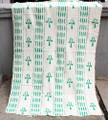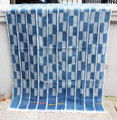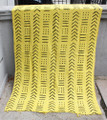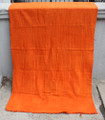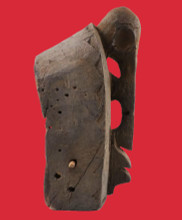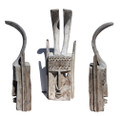 Loading... Please wait...
Loading... Please wait...- Home
- The Curators Gallery
- Dogon Dana an Hunters Mask
Product Description
The Dogon are one of the most well known ethnic groups in Africa with a remarkable historical legacy one that centers around accurate advanced knowledge of mathematics and astronomy yet how this was achieved still remain a mystery.
Their traditions and tribal ceremonies date back for thousands of years. Along with these mysterious origins of knowledge the Dogon are famous for their tribal works of art. Doors, statues and various ritual accoutrements, accompany over 70 masks of which only a few have clear-cut meaning to outsiders. The mask on display belong to a quartet of facial coverings that the Dogon has classified as "human predatory" masks. Such masks are believed to have been derived from an old Dogon myth.
*"Such a mask would be worn by a man more than 20 years old, the senior age-group in the Awa society. His costume would have been an ordinary tunic covered with leaves, combining domesticated and wild materials, and he would have carried a sword, a lance and a leather bag with medicines. In a pantomime rather than a dance, dannana aggressively hunts another masquerader, the rabbit, but fails to catch him. The rabbit in this context is the trickster, intelligent and cunning, able to defy man. The pairing of hunter and rabbit may refer to the myth recounting how the first hunter mask was created. A skilled hunter killed an antelope, and both the rabbit and the hyena asked for a share. After much discussion and some chasing, the rabbit tells the hunter that the hyena attacked him, whereupon the hunter kills the hyena. It should be noted that the Dogon consistently describe the hyena in negative terms: as an unprovoked attacker, ugly and smelly, and with a repulsive voice. In the myth, the hunter tells his father about killing the antelope and the hyena, and his father dies. The hunter perceives his father's death not as a coincidence but as being caused by the killing of the two animals. This is in keeping with the virtually universal African belief that all illnesses and deaths have more than physical causes. The Dogon myth concludes with the hunter carving masks. It is inferred that the hunter wanted to protect himself from the spirits of the animals he killed."
The honored craftsman chose a dark heavy hardwood perhaps to mimic the hides of prized prey. The basic construction is simplistic in nature, a flat front panel seamlessly joined by a single curved section that starts upward from the lower end of the mask, goes up and over the top back portion of the mask and descends downward to the bottom of the other side of the jaw. A wooden rod expands parallel across the rectangular back opening for the masker to grip if needed. The facial plane features a wooden bulge that juts out from the center forehead area of the mask with two rounded concave indentations on opposing sides indicating eye sockets. A long narrow extension drops downward from the lower portion of the bump emulating the trunk of an elephant. An animal like protruding mouth composed of two flattened slanted lips that at times can hold teeth of straw
The Dogon Dana is a well constructed, solid, heavy mask that adheres to traditional Dogon styling. This used facial covering is in good condition considering it's age crafted in the mid 20th century. It has being preserved in a collection prior to our acquisition.
Please click photo for enlargement!
Dimensions: 13 1/2 inches long x 6 1/2 inches from it's widest point x 7 inches deep
Any QUESTIONS please leave a message here at Contact Us!
*Fixed or free shipping for domestic orders only*
* Taken from French ethnographer Marcel Griaule's 1938 publication of photographs of a mask.



